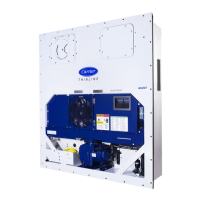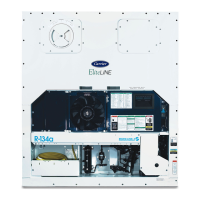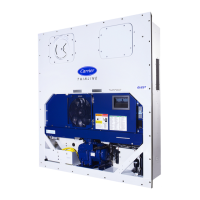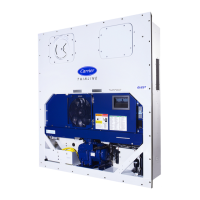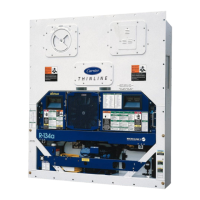5–7 T-365
The electronic phase detection system will check for proper compressor rotation within the
first 30 seconds. If rotation is not correct, the compressor will be stopped and restarted in the
opposite direction. If the compressor is producing unusually loud and continuous noise after
the first 30 seconds of operation, stop the unit and investigate.
5.6.1 Starting the Unit
1. With power properly applied, the fresh air vent in proper position, place the START−STOP switch to “I” (ON),
see Figure 3.5.
2. The Controller Function Codes for the container ID (Cd40), software version (Cd18) and unit model number
(Cd20) will be displayed in sequence.
3. Continue with Start Up Inspection, Section 5.7.
5.6.2 Stopping the Unit
To stop the unit, place the START−STOP switch in position “0” (OFF).
5.7 START−UP INSPECTION
5.7.1 Physical Inspection
Check rotation of condenser and evaporator fans.
5.7.2 Check Controller Function Codes
Check, and if required, reset controller Function Codes (Cd27 through Cd39) in accordance with desired operating
parameters. Refer to Table 4–3.
5.7.3 Start Temperature Recorder DataCORDER
1. Check and, if required, set the DataCORDER Configuration in accordance with desired recording parameter.
Refer to Section 4.8.3.
2. Enter a “Trip Start.” To enter a “Trip Start,” do the following:
a. Depress the ALT MODE key. When the left display shows, dC, depress the ENTER key.
b. Scroll to Code dC30.
c. Depress and hold the ENTER key for five seconds.
d. The “Trip Start” event will be entered in the Data-CORDER.
5.7.4 Complete Inspection
Allow the unit to run for five minutes to stabilize conditions, and then perform a Pre−trip diagnosis in accordance
with Section 4.7.
5.8 PRE−TRIP DIAGNOSIS
Pre−trip inspection should not be performed with critical temperature cargoes in the container.
When Pre−trip key is pressed, economy, dehumidification and bulb mode will be deactivated. At the
completion of Pre−trip activity, economy, dehumidification and bulb mode must be reactivated.
Pre−trip diagnosis provides automatic testing of the unit components using internal measurements and compari-
son logic. The program will provide a “PASS” or “FAIL” display to indicate test results.
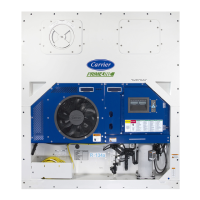
